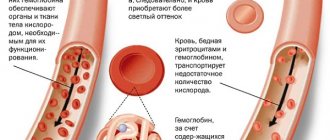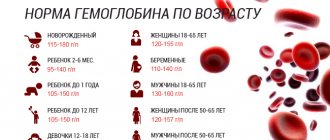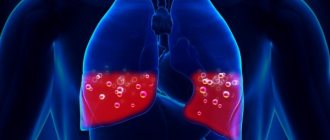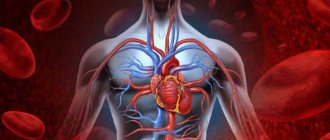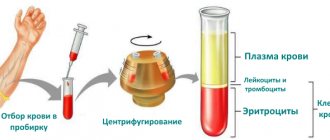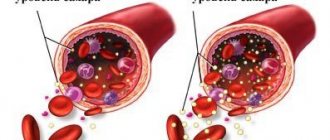Signs of cancer based on blood tests
Is it possible to determine oncology using a blood test?
Can. Diagnosis of cancer using a blood test is possible in two cases.
- When conducting a special oncological analysis - tumor markers, liquid biopsy, etc.
- When conducting a general analysis to detect leukemia (blood cancer). In this case, a complete blood count works like a standard biopsy for, for example, kidney cancer.
In other cases, signs of cancer can only be determined indirectly from a blood test.
Cancer develops through a complex process involving genetic mutations, tumorigenesis, and pathobiology. This process not only causes cancer-specific biological and pathological changes, but also causes general biochemical changes in either the systemic response to the cancer itself or to anticancer therapy. These changes are reflected in abnormal results of routine laboratory tests.
Reasons for decreased hemoglobin in the blood in oncology
Hemoglobin levels can change during cancer for a variety of reasons. It is important to establish the reason for the decrease in protein concentration in each specific case in order to know how to increase hemoglobin and prevent complications of the disease in the future.
The cause may be due to internal bleeding. Oncopathology often causes such a complication, especially with the active progression of a malignant tumor or against the background of an adverse reaction from prescribed therapy. Other reasons that may contribute to a decrease in serum hemoglobin levels are also identified:
- gastrointestinal dysfunction resulting from problems with iron absorption;
- spread of metastases to the bone marrow;
- loss of adequate nutrition (with cancer of the stomach, esophagus or intestines), resulting in iron deficiency in the body;
- the use of potent drugs and procedures (chemotherapy or radiation), the adverse reactions of which are a decrease in the ability to form hematopoiesis;
- acute intoxication of the body, due to the constant growth and disintegration of a malignant tumor in the last stages of oncology.
Indicators of general clinical blood test in oncology
Signs of oncology based on a general blood test are usually determined not in relation to any one indicator, but by a combination of several parameters. It is believed that if more than 4 analysis parameters are changed in a characteristic (for a specific disease) manner, there is a high risk of the presence of a tumor.
The difficulty lies in the fact that many indicators of a general blood test for different types of cancer change in different directions. With some cancers they may increase, with others they may decrease. Therefore, it is impossible to say that cancer can be determined with any certainty by a blood test (general test).
Hemoglobin
Blood hemoglobin decreases in cancer. This is due, first of all, to intoxication by tumor cell decay products and general depletion of energy resources.
Leukocytes
A strong increase in immature forms of leukocytes is characteristic of leukemia. At the same time, during chemotherapy for tumors, the number of leukocytes can decrease significantly.
Erythrocyte sedimentation rate (ESR)
This indicator always increases by 5-10 times in case of cancer. Even with severe chronic inflammation, the rise in ESR is usually less.
Platelets
Platelet counts may increase in some solid tumors and decrease in leukemia.
Indicators of a detailed blood test indicating suspicion of cancer
Direction of change in cancer
Men Women under 50 Women over 50
What should you be wary of?
The first indicator that should cause concern is the number of leukocytes and their qualitative composition. A general blood test for cancer usually shows a large number of leukocytes, which are significantly higher than normal. In cases of cancer, there are also many young forms of leukocytes in the blood. It is worth paying close attention to this indicator when deciphering a blood test.
With blood cancer, leukocytosis sometimes just goes off scale. An experienced laboratory doctor can even immediately determine the type of leukemia, because under a microscope one can see myeloblastomas or lymphoblastomas, which are characteristic of the body specifically in cancer. A blood test will not help answer the question of whether the process is chronic or acute. Only a bone marrow test will show this.
Can there be good indicators of a general or biochemical blood test for cancer?
Of course they can. Especially when it comes to the first stages of cancer. At the initial stages, no serious changes in clinical or biochemical blood parameters are detected.
This condition can last for years. And until the tumor begins to exhibit biochemical or endocrine activity, or until its size reaches the level where it begins to draw on the body’s energy resources, laboratory test results will remain normal.
How do indicators change during the development of cancer?
The main function of hemoglobin, a protein found in red blood cells, is the delivery of oxygen from the lungs to other organs and tissues of the body, transportation for the removal of carbon dioxide. A decrease in hemoglobin levels is diagnosed in more than half of patients with the development of cancer. This condition is called anemia, in simple terms - anemia.
Hemoglobin levels in a healthy person are within 140 units in men, 120 in women. A fluctuation of several units above or below the norm does not affect your well-being.
In people susceptible to cancer, its content begins to drop significantly and remains consistently low, especially with the development of cancer in the final stages. This condition is accompanied by weakness, chest pain, shortness of breath, the patient experiences dizziness, pale skin, and increased heart rate. When the indicator drops, a decrease in immunity, a depressed state or increased nervousness is observed.
Tests for cancer and other oncological diseases
In addition to general, or routine tests as they are also called, there are a number of specific blood tests used specifically to detect oncology. Such tests are much more accurate and provide the doctor with more information.
Special blood tests may be used to:
- screening of patients at high risk of cancer;
- clarification of the stage of cancer;
- identifying treatment options;
- assessing whether the cancer is responding to treatment.
Laboratory tests may also be used to determine whether a patient has a recurrence of cancer.
CTC blood test - liquid biopsy
The Cellsearch™ circulating tumor cell (CTC) test can be used to monitor metastatic breast cancer, colorectal cancer and prostate cancer. This diagnostic test helps collect, identify and count circulating tumor cells in a blood sample. CTCs are cancer cells that break off from solid tumors and enter the bloodstream. CTC testing may be performed before starting therapy or during the course of treatment.
Flow cytometry
This test is used to diagnose and classify certain types of cancer, such as leukemia and lymphoma, and to assess the risk of recurrence. Flow cytometry can also be used as part of the stem cell transplant process.
Flow cytometry measures the properties of cells in a sample of blood or bone marrow. The sample is first processed and placed under a laser beam. If antibodies attach to cells, the cells emit light.
Flow cytometry can also be used to measure the amount of DNA in cancer cells. In this case, the cells are treated with special light-sensitive dyes that react with DNA. For patients with breast, prostate or bladder cancer, an abnormal amount of DNA may indicate recurrence.
What are tumor markers?
Tumor markers are substances in the body that are produced in much higher quantities when cancer or certain benign conditions are present. The substances can be found in blood, urine, stool or tumor tissue. Most of these substances are proteins, but sometimes gene expression patterns and DNA changes are also used as tumor markers.
Because an elevated tumor marker does not necessarily indicate cancer, cancer markers cannot be used alone to diagnose cancer. Typically, tumor marker measurements are used in combination with other tests, such as a biopsy.
Find out more about new opportunities for diagnosing cancer in the early stages using laboratory tests for tumor markers and tumor DNA. Write to us or request a call back.
source
What blood test indicators show oncology (cancer)
Diagnosis of cancer tumors is a comprehensive examination using specific instrumental and laboratory methods. It is carried out according to indications, including disorders identified by a standard clinical blood test.
Malignant neoplasms grow very intensively, consuming vitamins and microelements, as well as releasing waste products into the blood, leading to significant intoxication of the body. Nutrients are taken from the blood, and the products of their processing also enter there, which affects its composition. Therefore, it is often during routine examinations and laboratory tests that signs of a dangerous disease are discovered.
Hemoglobin level during chemotherapy
As a result of clinical and laboratory studies, it was found that malignant tumor cells that do not receive the required portion of oxygen cannot be destroyed as a result of chemotherapy. Due to low oxygenation, cancer cells increase resistance by 6 times. If the oxygen supply is normal, susceptibility to chemotherapy remains.
An undesirable side effect of chemotherapy is deterioration of blood composition. Usually the number of constituent blood cells decreases. Repeated treatment and complications caused by cancer lead to a slight decrease in the hemoglobin level. Subsequently, the condition worsens or becomes chronic. To prescribe auxiliary treatment, the oncologist assesses the state of physiological fluid over time. If the level of iron-containing protein is raised, the prognosis for recovery increases, the patient’s quality of life improves, and aggressive anticancer treatment is more effective.
What blood tests show cancer?
Cancer can be suspected based on the results of standard and special studies. During pathological processes in the body, changes in the composition and properties of blood are reflected in:
- general blood test;
- biochemical research;
- analysis for tumor markers.
However, cancer cannot be reliably determined by a blood test. Deviations in any indicators can be caused by diseases that are in no way related to oncology. Even the specific and most informative analysis for tumor markers does not provide a 100% guarantee of the presence or absence of the disease and needs to be confirmed.
Is it possible to determine oncology (cancer) using a general blood test?
This type of laboratory test gives an idea of the number of basic formed elements that are responsible for blood functions. A decrease or increase in any indicators is a signal of trouble, including the presence of neoplasms. A sample is taken from a finger (sometimes from a vein) in the first half of the day, on an empty stomach. The table below shows the main categories of general or clinical blood tests and their normal values.
When interpreting analyses, it is necessary to take into account that depending on gender and age, indicators may vary, and there are also physiological reasons for increasing or decreasing values.
| Name, unit of measurement | Description | Quantity |
| Hemoglobin (HGB), g/l | Component of red blood cells that transports oxygen | 120-140 |
| Red blood cells (RBC), cells/l | Red cell count indicator | 4-5x10 12 |
| Color index | Has diagnostic value for anemia | 0,85-1,05 |
| Reticulocytes (RTC). % | Young red blood cells | 0,2-1,2% |
| Platelets (PLT), cells/l | Provide hemostasis | 180-320x10 9 |
| ESR (ESR), mm/h | Plasma sedimentation rate of erythrocytes | 2-15 |
| Leukocytes (WBC), cells/l | Perform protective functions: maintaining immunity, fighting foreign agents and removing dead cells | 4-9x10 9 |
| Lymphocytes (LYM), % | These elements are components of the concept of “leukocytes”. Their number and ratio is called the leukocyte formula, which has important diagnostic value for many diseases | 25-40 |
| Eosinophils, % | 0,5-5 | |
| Basophils, % | 0-1 | |
| Monocytes, % | 3-9 | |
| Neutrophils: band | 1-6 | |
| segmented | 47-72 | |
| myelocytes | 0 | |
| metamyelocytes | 0 |
Almost all of these blood parameters change in the direction of decrease or increase in oncology. What exactly does the doctor pay attention to when studying the test results:
- ESR. The erythrocyte sedimentation rate in plasma is higher than normal. Physiologically, this can be explained by menstruation in women, increased physical activity, stress, etc. However, if the excess is significant and is accompanied by symptoms of general weakness and low-grade fever, cancer can be suspected.
- Neutrophils. Their number has been increased. The appearance of new, immature cells (myelocytes and metamyelocytes) in the peripheral blood, characteristic of neuroblastomas and other oncological diseases, is especially dangerous.
- Lymphocytes. These CBC indicators in oncology are higher than normal, since it is this element of the blood that is responsible for immunity and fights cancer cells.
- Hemoglobin. Decreases if there are tumor processes in internal organs. This is explained by the fact that waste products of tumor cells damage red blood cells, reducing their number.
- Leukocytes. The number of white blood cells, as shown by oncology tests, always decreases if the bone marrow is affected by metastases. The leukocyte formula shifts to the left. Neoplasms of other localization lead to an increase.
It should be borne in mind that a decrease in hemoglobin and the number of red blood cells is characteristic of ordinary anemia caused by iron deficiency. An increase in ESR is observed during inflammatory processes. Therefore, such signs of oncology from a blood test are considered indirect and need confirmation.
Biochemical research
The purpose of this analysis, carried out annually, is to obtain information about metabolism, the functioning of various internal organs, the balance of vitamins and microelements. A biochemical blood test for oncology is also informative, since changes in certain values allow one to draw conclusions about the presence of cancerous tumors. From the table you can find out what indicators should be normal.
A biochemical blood test can suspect cancer if the following values do not correspond to the norm:
- Albumin and total protein. They characterize the total amount of proteins in the blood serum and the content of the main one. The developing tumor actively consumes protein, so this indicator is significantly reduced. If the liver is affected, then even with adequate nutrition there is a deficiency.
- Glucose. Cancer of the reproductive (especially female) system, liver, and lungs affects insulin synthesis, inhibiting it. As a result, symptoms of diabetes mellitus appear, which is reflected in a biochemical blood test for cancer (sugar levels increase).
- Alkaline phosphatase. It increases primarily with bone tumors or metastases to them. It may also indicate oncology of the gallbladder or liver.
- Urea. This criterion allows you to evaluate the functioning of the kidneys, and if it is elevated, there is a pathology of the organ or there is an intensive breakdown of protein in the body. The latter phenomenon is characteristic of tumor intoxication.
- Bilirubin and alanine aminotransferase (ALT). An increase in the amount of these compounds informs about liver damage, including cancer.
If cancer is suspected, a biochemical blood test cannot be used to confirm the diagnosis. Even if there are coincidences on all points, additional laboratory tests will be required. As for donating blood directly, it is taken from a vein in the morning, but eating and drinking (it is allowed to drink boiled water) has not been allowed since the previous evening.
Basic Analysis
If a biochemical and general blood test for oncology only gives a general idea of the presence of a pathological process, then a study of tumor markers can even determine the location of a malignant neoplasm. This is the name of a blood test for cancer, which detects specific compounds produced by the tumor itself or the body in response to its presence.
In total, about 200 tumor markers are known, but a little more than twenty are used for diagnosis. Some of them are specific, that is, they indicate damage to a specific organ, while others can be detected in different types of cancer. For example, alpha-fetoprotein is a common tumor marker for cancer; it is found in almost 70% of patients. The same applies to CEA (carcinoembryonic antigen). Therefore, to determine the type of tumor, the blood is tested for a combination of general and specific tumor markers:
- Protein S-100, NSE – brain;
- SA-15-3, SA-72-4, REA – the mammary gland is affected;
- SCC, alpha-fetoprotein – cervix;
- AFP, CA-125, hCG – ovaries;
- CYFRA 21–1, REA, NSE, SCC – lungs;
- AFP, CA 19-9, CA-125 – liver;
- CA 19-9, REA, CA 242 – stomach and pancreas;
- SA-72-4, REA – intestines;
- PSA – prostate gland;
- hCG, AFP – testicles;
- Protein S-100 – skin.
But despite all the accuracy and information content, the diagnosis of oncology using a blood test for tumor markers is preliminary. The presence of antigens can be a sign of inflammatory processes and other diseases, and CEA is always elevated in smokers. Therefore, without confirmation by instrumental studies, the diagnosis is not made.
Can there be a good blood test for cancer?
This question is natural. If poor results are not confirmation of oncology, then could it be the other way around? Yes it is possible. The test result may be affected by the small size of the tumor or the use of medications (given that for each tumor marker there is a specific list of drugs, the use of which can lead to false-positive or false-negative results, the attending physician and laboratory staff should be notified about the drugs taken by the patient).
Even if the blood tests are good and instrumental diagnostics have not given any results, but there are subjective complaints of pain, we can talk about an extra-organ tumor. For example, its retroperitoneal variety is detected already at stage 4, before which it practically does not make itself felt. The age factor also matters, since metabolism slows down over the years, and antigens also enter the blood slowly.
What blood indicators indicate cancer in women?
The risk of getting cancer is approximately the same in both sexes, but the fair half of humanity has an additional vulnerability. The female reproductive system is at high risk of cancer, especially the mammary glands, which makes breast cancer the 2nd most common among all malignant neoplasms. The epithelium of the cervix is also prone to malignant degeneration, so women should take examinations responsibly and pay attention to the following test results:
- CBC in oncology shows a decrease in the level of red blood cells and hemoglobin, as well as an increase in ESR.
- Biochemical analysis - here the cause for concern is an increase in the amount of glucose. Such symptoms of diabetes are especially dangerous for women, as they often become harbingers of breast and uterine cancer.
- When examining tumor markers, the simultaneous presence of SCC antigens and alpha-fetoprotein indicates a risk of cervical lesions. Glycoprotein CA 125 is a threat to endometrial cancer, AFP, CA-125, hCG - ovarian cancer, and the combination of CA-15-3, CA-72-4, CEA indicates that the tumor can be localized in the mammary glands.
If there is something alarming in the tests and there are characteristic signs of oncology in the initial stage, a visit to the doctor cannot be postponed. In addition, you should visit a gynecologist at least once a year, and regularly examine your breasts yourself. These simple preventive measures often help detect cancer in its early stages.
Leukocytes in oncology
In most patients, the number of leukocytes in the blood serum during oncology increases significantly (leukocytosis) to fight mutant cells in the body. The number of white blood cells is under the control of the human immune system. When natural defenses are weakened, malignant cells begin to divide so quickly that white blood cells do not have time to destroy them.
If the normal value of the indicator in people over 16 years of age ranges from 4 to 10 * 109 units, then leukocytes in cancer reach critical values. It should be noted that standard values for the value under consideration in cancer have not been established, since they can vary over a fairly wide amplitude (from slight increases to tenfold).
What do low values of leukocytes in the blood indicate in oncology?
In medicine, this condition is called leukopenia. It is noted that most often this condition develops in patients undergoing chemotherapy. This happens because the human body does not accept the prescribed drug, and there is no positive dynamics in the treatment of cancer pathology. Doctors adjust the course of therapy and transfer the patient to more aggressive treatment methods that negatively affect the cellular composition of the blood.
In addition, malfunctions of the kidneys and liver, which lose their ability to remove toxins from the body, can lead to leukopenia.
A low concentration of white blood cells in diseases, including cancer, can also be detected in bone marrow dysfunction. For example, in patients under the age of 30, leukopenia occurs much less frequently than in older patients. This is explained by the fact that the bone marrow of a young organism has a higher reserve of leukocyte synthesis.
It should be noted that the results of a general blood test also depend on the patient’s diet. In a situation where the body receives few nutrients, it begins to become depleted, which means the negative effects of chemotherapy drugs become more pronounced.
Read further: How to quickly increase white blood cells in the blood after chemotherapy at home?
When is tumor marker analysis necessary?
You should undergo an examination if there is a prolonged deterioration in your health in the form of weakness, constant low temperature, fatigue, weight loss, anemia of unknown origin, enlarged lymph nodes, the appearance of lumps in the mammary glands, changes in the color and size of moles, disturbances in the gastrointestinal tract, accompanied by the discharge of blood after defecation, obsessive cough without signs of infection, etc.
Additional reasons are:
- age over 40;
- family history of cancer;
- exceeding the normal range of biochemical analysis and blood test results;
- pain or prolonged dysfunction of any organs or systems, even to a minor extent.
The analysis does not take much time, while helping to identify a life-threatening disease in time and treat it in the least traumatic way. In addition, such examinations should become regular (at least once a year) for those who have relatives with cancer or have crossed the age of forty.
How to prepare for a tumor marker test
Blood for antigen tests is donated from a vein in the morning. Results are issued within 1-3 days, and in order for them to be reliable, you must follow certain recommendations:
- don't have breakfast;
- do not take any medications or vitamins the day before;
- three days before diagnosing cancer using a blood test, avoid alcohol;
- do not eat fatty or fried foods the day before;
- the day before the study, avoid heavy physical activity;
- on the day of delivery, do not smoke in the morning (smoking increases CEA);
- To prevent third-party factors from distorting the indicators, first cure all infections.
After receiving the results in hand, you should not draw any independent conclusions or make diagnoses. This blood test for cancer is not 100% reliable and requires instrumental confirmation.
source
What indicators of a general blood test indicate oncology?
More than eight million people die from cancer every year around the world. This is 13 percent of the total number of deaths on the planet. Oncologists say that the greatest danger of cancer lies not even in themselves, but in late diagnosis.
Often, oncological processes in the body occur secretly, without external manifestations, and the patient does not suspect anything until the disease reaches a late stage. At this stage, treatment is no longer effective, which explains the high mortality rate from this group of pathologies.
Early diagnosis of cancer is the main goal of modern medicine. But there are no accessible and accurate rapid tests. Therefore, it is very important to be attentive to indirect signs that may indicate the development of cancer.
Is it possible to determine oncology from a blood test?
Two blood tests are quite common in medicine: general or clinical and biochemical. They are considered basic.
| The indicators of these analyzes are nonspecific. Deviations from the norm do not indicate a specific disease. They show that pathological changes occur in the body, which require additional examination to establish a diagnosis. |
The same applies to cancer. General and biochemical blood tests cannot indicate the development of cancer pathology. But they may give rise to a more in-depth study to determine cancer markers.
Clinical blood test indicators for oncology
A clinical blood test allows you to conduct research on six indicators. Each of them, in case of deviation from the norm, indicates certain malfunctions in the functioning of vital systems.
Let's take a closer look at the indicators of a general blood test that may go beyond the normal range for cancer.
Hemoglobin
Hemoglobin is a complex protein that binds to oxygen and transports it to tissues. In the blood, hemoglobin is a component of red blood cells. Normal hemoglobin levels in adults look like this:
| Category of people | Hemoglobin norm |
| Women | 120-150 g/l |
| Men | 130-160 g/l |
With oncological pathologies, the level of hemoglobin in the blood decreases. Anemia or low hemoglobin levels are observed with tumors of internal organs with concomitant damage to the hematopoietic system. There are four main causes of anemia in oncology:
- problems with iron absorption;
- metastases in the bone marrow that block the production of hemoglobin;
- intoxication of the body;
- malnutrition without the proper amount of iron.
Leukocytes
Leukocytes are white blood cells that are normally present in the blood at a concentration of 4-9*109/l. These particles perform the body’s protective function against foreign antigens. With cancer, the level of white blood cells may increase or decrease.
Elevated white blood cells are observed in leukemia and cancer of any location. But leukocytosis is a nonspecific indicator. There are many factors for its development, and oncology is only one of them.
The cause of a reduced level of white blood cells (leukopenia) among cancer diseases can be:
- acute leukemia,
- metastases of neoplasms in the bone marrow,
- myelofibrosis,
- plasmacytoma.
It is believed that the leukocyte count is the main tumor marker in a general blood test. In case of serious deviations from the norm, a more in-depth examination is necessary.
Erythrocyte sedimentation rate (ESR)
ESR is an indicator that shows the rate of erythrocyte sedimentation under the influence of gravity. Normally, the ESR is:
| Category of people | ESR norm |
| Newborns | 0-2 mm/h |
| Children under six years old | 12-17 mm/h |
| Men under 60 years of age | no more than eight mm/h |
| Women under 60 years of age | no more than 12 mm/h |
| Men over 60 years of age | no more than 15 mm/h |
| Women over 60 years old | no more than 20 mm/h |
A cause for concern is an ESR exceeding the norm by three to five times. In terms of oncological problems, it may indicate malignant tumors localized in any organ, as well as blood oncology.
Platelets
Platelets are nuclear-free blood elements that are responsible for two important functions:
- closing the site of vessel damage by forming a primary plug (blood clotting);
- acceleration of plasma coagulation reactions.
Platelet standards depend on the age and gender of the person:
| Category of people | Platelet rate |
| Newborns | 100,000-420,000 U/µl |
| Children under one year old | 150,000-350,000 U/µl |
| Children from one to five years old | 180,000-380,000 U/µl |
| Children from five to seven years old | 180,000-450,000 U/µl |
| Men | 200,000-400,000 U/µl |
| Women | 180,000-320,000 U/µl |
Deviations from the norm of platelets are dangerous both in the direction of decrease and in the direction of increase. Thrombocytopenia (a decrease in platelet count below 100,000 U/μl) is characteristic of leukemia, and thrombocytosis (an increase in the rate in adults above 400,000 U/l) is characteristic of cancer pathologies of any location.
Symptoms of pathology
Symptoms of anemia depend on the level of hemoglobin in the body. When the readings drop to 90, patients experience impaired concentration and memory. If hemoglobin decreases by another twenty units, a person develops shortness of breath, tinnitus, and arrhythmia. Paleness of the skin. If hemoglobin begins to decrease further, heart failure develops and the following symptoms:
- deformation of the nail plates due to their depletion;
- dry skin and mucous membranes;
- formation of cracks around the oral cavity;
- taste disturbance;
- increase in body temperature.
Cancerous anemia can be diagnosed using a laboratory blood test. Such a study must be carried out repeatedly throughout the course of treatment of the pathology, which makes it possible to assess the dynamics of the development of a cancerous tumor. It is also recommended to monitor your blood sugar levels.
Indicators of biochemical blood analysis in oncology
Signals for an in-depth examination for oncology in a biochemical blood test are the following indicators going beyond the norm:
- total protein,
- urea,
- sugar level
- bilirubin,
- AlAT,
- alkaline phosphatase.
Let’s look at what each indicator goes beyond the normal range to indicate in the table:
| Biochemical blood test indicator | Norm | Excess or decrease | Probable Cause |
| Total protein | 64-83 g/l | Decline | Liver cancer, tumors of any location. |
| Urea | 2.5-8.3 mmol/l | Promotion | Tumor intoxication, decay of tumor tissue. |
| Blood sugar | 3.33-5.55 mmol/l | Promotion | Cancer of the lungs, liver, breast, uterus, reproductive system. Sarcomas. |
| Bilirubin | 3.4-17.1 µmol/l | Promotion | Liver cancer. |
| ALT (Alanine aminotransferase) | 31 U/L in women, 41 U/L in men | Promotion | Liver cancer. |
| Alkaline phosphatase | 32-105 U/l in women, 40-130 U/l in men | Promotion | Bone cancer, liver cancer, gallbladder cancer. |
Exceeding the normal range of any of these indicators does not allow diagnosing cancer. This may be a sign of many problems not related to cancer. But this is a reason to conduct an in-depth study to find the cause of a poor biochemical blood test.
Increased hemoglobin in oncology
Typically, in patients with malignant neoplasms, the level of iron-containing protein and red blood cells decreases. But sometimes these levels are elevated if the cancer affects the organs involved in the production of erythropoietin. This hormone stimulates bone marrow function and red blood cell synthesis. Therefore, hemoglobin does not fall even with developing cancer.
Oncopathologies that cause an increase in hemoglobin include:
- kidney cancer;
- hepatoma and multiple liver cysts;
- adrenal cancer;
- adenoma of the anterior pituitary gland.
Also, increased levels of iron-containing protein are sometimes found with masculinizing ovarian formation and uterine fibroids. Blood tests are done regularly to determine the severity. Their results help determine the etiology of cancer and evaluate the effectiveness of treatment.
Can there be good indicators of a general or biochemical blood test for cancer?
Clinical and biochemical blood tests are not important in the diagnosis of cancer. They can show problems in the body, but do not specifically indicate cancer.
In case of oncology, can all the indicators of these tests be normal? Rarely, but they can. Leukocytosis, increased ESR and anemia cause cancer problems almost always. But cancer requires a more in-depth diagnosis. No doctor can make a diagnosis or state the absence of problems of this nature solely based on a general blood test.
Oncological problems require a comprehensive assessment of all symptoms and manifestations by a doctor specializing in cancer.
Normalization of hemoglobin in gastrointestinal cancer
Due to disturbances in the functioning of the gastrointestinal tract, as well as the impossibility of normal nutrition, iron in the body is not able to be absorbed. Conditions in which internal bleeding is observed are especially dangerous. In this case, drugs to increase hemoglobin in oncology in the form of tablets will not give any result, so injections or blood transfusions are used. In pathologies of the gastrointestinal tract, hemoglobin is always much lower than normal, which complicates the treatment of the disease.
Note! Blood transfusions for cancer anemia are performed in extreme cases due to the possibility of a sharp increase in the load on the cardiac and vascular systems. It is also not used for heart attacks, strokes, heart failure and thrombosis.
Tests for oncology (cancer)
An analysis that allows you to get an objective picture of the presence of oncological problems is a blood test for tumor markers. This term refers to antigens that are produced by cancer cells. They are present in the body of every person, but with cancer their concentration increases many times over.
The analysis is taken several times to see the dynamics. But even the presence of blood tumor markers in high concentrations is not a reason to make a diagnosis yourself. There are several third-party factors that can provoke an increase in their number:
- colds,
- pregnancy,
- some non-oncological diseases.
The blood test for tumor markers must be deciphered by an oncologist who can competently draw up a picture of the patient’s tests and medical history and make the correct diagnosis or prescribe additional examinations.
source
Hemoglobin and cancer
Some believe that anemia can cause the development of cancer. However, here everything is different: anemia is a symptom of cancer, its consequence. It can be caused by the disease itself, chemotherapy drugs, or the development of concomitant diseases. However, anemia itself is not capable of affecting the formation of a tumor in the human body. Low hemoglobin most often occurs with cancer of the stomach, intestines, and uterus (due to bleeding). Anemia also occurs in patients with leukemia. If the cause of this symptom is the side effects of chemotherapy drugs, doctors will have to adjust the dose or replace the drugs with gentler versions. In addition, medications with a high iron content can be prescribed: this will quickly restore the required hemoglobin level.
Features of changes in general blood test indicators in oncology
It is impossible to say unequivocally what a blood test will be like for malignant diseases. It depends on what type of tumor develops; in addition, its location and the nature of the disease are considered. The individual characteristics of each person’s body are also important.
But it is still possible to identify some general distinctive features of the results of a blood test that will help an experienced doctor suspect the development of a malignant process.
Leukocytes
According to the interpretation of the blood test, in oncology the qualitative composition and quantitative value of leukocytes changes . Leukocytes are white blood cells that take part in the body’s immune defense against viral, bacterial, and parasitic infections. In a clinical blood test, cancer usually shows a significant increase in the number of white blood cells. A characteristic feature of the development of a malignant process is an increase in the level of leukocytes in the blood due to their young forms. The content of leukocytes increases most significantly in leukemia - malignant diseases of the hematopoietic system. Depending on the type of leukemia, a blood test may show lymphoblasts (precursors of lymphocytes) and myeloblasts (precursors of neutrophils).
In most cases, a general blood test for oncology determines a high ESR value - erythrocyte sedimentation rate. This indicator is an indirect characteristic of the content of blood plasma proteins. The doctor should be alert to the fact that the use of antibacterial or anti-inflammatory treatment does not lead to a decrease in the value of this blood indicator.
Hemoglobin
Another important blood indicator, a decrease in the value of which may indicate the development of a malignant process, is hemoglobin. Hemoglobin is a special protein found in red blood cells that is responsible for transporting oxygen from the lungs to organs and tissues, and carbon dioxide back. The doctor should be alerted to a decrease in hemoglobin in the blood if the patient does not have blood loss (during major operations, injuries, heavy menstruation). It is important that the person eats normally and leads a normal lifestyle.
The most significant and rapid decrease in hemoglobin occurs with the development of intestinal and stomach cancer. In some types of leukemia and liver cancer, in addition to a decrease in ESR, a decrease in the number of platelets is observed, and the blood clotting rate increases. A blood test for colon cancer determines anemia due to hidden bleeding. In this case, this is an early symptom of a malignant tumor. With a metastatic tumor, a decrease in hemoglobin in the blood (anemia) often develops as a result of secondary damage to the bone marrow (hematopoietic organ).
Ways to increase hemoglobin in oncology
Therapy aimed at normalizing iron-containing protein in malignant neoplasms depends on the severity of anemia. First, the causes of complications are eliminated. Then, to increase hemoglobin, a therapeutic diet and a course of special medications are prescribed. In emergency cases, red blood cell transfusions are performed.
Medicines that increase hemoglobin
Sometimes the cause of a decrease in hemoglobin protein is a side effect of anticancer drugs. Then, to normalize the condition, the treatment regimen is reviewed. To do this, medications are replaced with safer ones or the dosage of medications already used is changed.
Important! When changing the treatment regimen, the possible risks are initially assessed. The new therapy may be ineffective or dangerous for the patient.
To increase hemoglobin after chemotherapy, the following medications are used:
- The Totem solution, in addition to iron, contains manganese and copper. They improve the absorption of the main microelement.
- Chewable tablets “Maltofer Fol” contain iron and folic acid. They should not be used for peptic ulcers of the intestines and stomach.
- The composition of Sorbifer Durules tablets, in addition to iron, includes ascorbic acid. This component stimulates the patient’s immunity, which worsens during chemotherapy.
- Actiferrin syrup contains iron and serine, which improves the absorption of beneficial microelements.
- Ferro-Folgamma capsules are a complex preparation. In addition to iron, they include vitamin B12 and folic acid.
To increase hemoglobin after chemotherapy, erythropoietin drugs are sometimes used. They are analogues of the hormone that stimulates the formation of red blood cells in the brain. It is mainly produced in the kidneys. Treatment with erythropoiesis-stimulating agents is carried out separately or in combination with iron supplements. After completing the full course of therapy, the hemoglobin level in cancer patients increases to 70%. The disadvantage of this treatment is serious complications. Therefore, erythropoietin preparations are used very carefully, under constant medical supervision.

